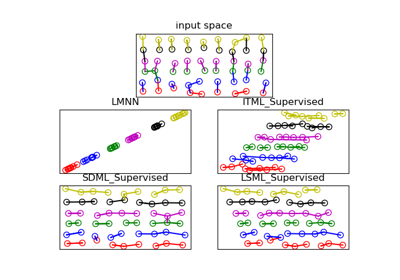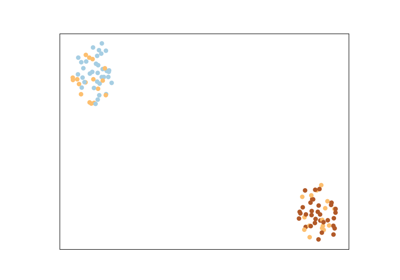metric_learn.base_metric.MahalanobisMixin
- class metric_learn.base_metric.MahalanobisMixin(preprocessor=None)[source]
Mahalanobis metric learning algorithms.
Algorithm that learns a Mahalanobis (pseudo) distance \(d_M(x, x')\), defined between two column vectors \(x\) and \(x'\) by: \(d_M(x, x') = \sqrt{(x-x')^T M (x-x')}\), where \(M\) is a learned symmetric positive semi-definite (PSD) matrix. The metric between points can then be expressed as the euclidean distance between points embedded in a new space through a linear transformation. Indeed, the above matrix can be decomposed into the product of two transpose matrices (through SVD or Cholesky decomposition): \(d_M(x, x')^2 = (x-x')^T M (x-x') = (x-x')^T L^T L (x-x') = (L x - L x')^T (L x- L x')\)
- Attributes:
- components_numpy.ndarray, shape=(n_components, n_features)
The learned linear transformation
L.
Methods
Returns a copy of the Mahalanobis matrix learned by the metric learner.
Get metadata routing of this object.
Returns a function that takes as input two 1D arrays and outputs the value of the learned metric on these two points.
get_params([deep])Get parameters for this estimator.
pair_distance(pairs)Returns the learned Mahalanobis distance between pairs.
pair_score(pairs)Returns the opposite of the learned Mahalanobis distance between pairs.
score_pairs(pairs)Returns the learned Mahalanobis distance between pairs.
set_params(**params)Set the parameters of this estimator.
transform(X)Embeds data points in the learned linear embedding space.
- __init__(preprocessor=None)
- get_mahalanobis_matrix()[source]
Returns a copy of the Mahalanobis matrix learned by the metric learner.
- Returns:
- Mnumpy.ndarray, shape=(n_features, n_features)
The copy of the learned Mahalanobis matrix.
- get_metadata_routing()
Get metadata routing of this object.
Please check User Guide on how the routing mechanism works.
- Returns:
- routingMetadataRequest
A
MetadataRequestencapsulating routing information.
- get_metric()[source]
Returns a function that takes as input two 1D arrays and outputs the value of the learned metric on these two points. Depending on the algorithm, it can return a distance or a similarity function between pairs.
This function will be independent from the metric learner that learned it (it will not be modified if the initial metric learner is modified), and it can be directly plugged into the metric argument of scikit-learn’s estimators.
- Returns:
- metric_funfunction
The function described above.
See also
pair_distancea method that returns the distance between several pairs of points. Unlike get_metric, this is a method of the metric learner and therefore can change if the metric learner changes. Besides, it can use the metric learner’s preprocessor, and works on concatenated arrays.
pair_scorea method that returns the similarity score between several pairs of points. Unlike get_metric, this is a method of the metric learner and therefore can change if the metric learner changes. Besides, it can use the metric learner’s preprocessor, and works on concatenated arrays.
Examples
>>> from metric_learn import NCA >>> from sklearn.datasets import make_classification >>> from sklearn.neighbors import KNeighborsClassifier >>> nca = NCA() >>> X, y = make_classification() >>> nca.fit(X, y) >>> knn = KNeighborsClassifier(metric=nca.get_metric()) >>> knn.fit(X, y) KNeighborsClassifier(algorithm='auto', leaf_size=30, metric=<function MahalanobisMixin.get_metric.<locals>.metric_fun at 0x...>, metric_params=None, n_jobs=None, n_neighbors=5, p=2, weights='uniform')
- get_params(deep=True)
Get parameters for this estimator.
- Parameters:
- deepbool, default=True
If True, will return the parameters for this estimator and contained subobjects that are estimators.
- Returns:
- paramsdict
Parameter names mapped to their values.
- pair_distance(pairs)[source]
Returns the learned Mahalanobis distance between pairs.
This distance is defined as: \(d_M(x, x') = \sqrt{(x-x')^T M (x-x')}\) where
Mis the learned Mahalanobis matrix, for every pair of pointsxandx'. This corresponds to the euclidean distance between embeddings of the points in a new space, obtained through a linear transformation. Indeed, we have also: \(d_M(x, x') = \sqrt{(x_e - x_e')^T (x_e- x_e')}\), with \(x_e = L x\) (SeeMahalanobisMixin).- Parameters:
- pairsarray-like, shape=(n_pairs, 2, n_features) or (n_pairs, 2)
3D Array of pairs to score, with each row corresponding to two points, for 2D array of indices of pairs if the metric learner uses a preprocessor.
- Returns:
- scoresnumpy.ndarray of shape=(n_pairs,)
The learned Mahalanobis distance for every pair.
See also
get_metrica method that returns a function to compute the metric between two points. The difference with pair_distance is that it works on two 1D arrays and cannot use a preprocessor. Besides, the returned function is independent of the metric learner and hence is not modified if the metric learner is.
- Mahalanobis Distances
The section of the project documentation that describes Mahalanobis Distances.
- pair_score(pairs)[source]
Returns the opposite of the learned Mahalanobis distance between pairs.
- Parameters:
- pairsarray-like, shape=(n_pairs, 2, n_features) or (n_pairs, 2)
3D Array of pairs to score, with each row corresponding to two points, for 2D array of indices of pairs if the metric learner uses a preprocessor.
- Returns:
- scoresnumpy.ndarray of shape=(n_pairs,)
The opposite of the learned Mahalanobis distance for every pair.
See also
get_metrica method that returns a function to compute the metric between two points. The difference with pair_score is that it works on two 1D arrays and cannot use a preprocessor. Besides, the returned function is independent of the metric learner and hence is not modified if the metric learner is.
- Mahalanobis Distances
The section of the project documentation that describes Mahalanobis Distances.
- score_pairs(pairs)[source]
Returns the learned Mahalanobis distance between pairs.
This distance is defined as: \(d_M(x, x') = \\sqrt{(x-x')^T M (x-x')}\) where
Mis the learned Mahalanobis matrix, for every pair of pointsxandx'. This corresponds to the euclidean distance between embeddings of the points in a new space, obtained through a linear transformation. Indeed, we have also: \(d_M(x, x') = \\sqrt{(x_e - x_e')^T (x_e- x_e')}\), with \(x_e = L x\) (SeeMahalanobisMixin).Deprecated since version 0.7.0: Please use pair_distance instead.
Warning
This method will be removed in 0.8.0. Please refer to pair_distance or pair_score. This change will occur in order to add learners that don’t necessarily learn a Mahalanobis distance.
- Parameters:
- pairsarray-like, shape=(n_pairs, 2, n_features) or (n_pairs, 2)
3D Array of pairs to score, with each row corresponding to two points, for 2D array of indices of pairs if the metric learner uses a preprocessor.
- Returns:
- scoresnumpy.ndarray of shape=(n_pairs,)
The learned Mahalanobis distance for every pair.
See also
get_metrica method that returns a function to compute the metric between two points. The difference with score_pairs is that it works on two 1D arrays and cannot use a preprocessor. Besides, the returned function is independent of the metric learner and hence is not modified if the metric learner is.
- Mahalanobis Distances
The section of the project documentation that describes Mahalanobis Distances.
- set_params(**params)
Set the parameters of this estimator.
The method works on simple estimators as well as on nested objects (such as
Pipeline). The latter have parameters of the form<component>__<parameter>so that it’s possible to update each component of a nested object.- Parameters:
- **paramsdict
Estimator parameters.
- Returns:
- selfestimator instance
Estimator instance.
- transform(X)[source]
Embeds data points in the learned linear embedding space.
Transforms samples in
XintoX_embedded, samples inside a new embedding space such that:X_embedded = X.dot(L.T), whereLis the learned linear transformation (SeeMahalanobisMixin).- Parameters:
- Xnumpy.ndarray, shape=(n_samples, n_features)
The data points to embed.
- Returns:
- X_embeddednumpy.ndarray, shape=(n_samples, n_components)
The embedded data points.

